Take a look at the strings on your guitar, and you’ll notice that they’re different thicknesses. The measurement of each string’s thickness is known as its “string gauge”. The string gauge of a guitar string has a dramatic effect on how it feels and sounds to play.
In this guide, I’ve covered everything that a beginner needs to know about guitar string gauge, to help you to understand one of the most important factors that affects your guitar.
Affiliate disclaimer: This page contains affiliate links for products that I’ve tried and tested. As an Amazon Associate I earn from qualifying purchases at no additional cost to you. Learn more here.
What is guitar string gauge?
Guitar string gauge is a measurement of how thick a guitar string is. It’s usually expressed as 1/1000th of an inch. For example, a string that’s 0.009 inches thick would be a string gauge 9.
The higher the string gauge, the thicker the string is. So, you’ll sometimes hear guitar strings referred to as “higher gauge” (thicker) or “lower gauge” (thinner). They’re also known as “heavy gauge” (thicker) and “lighter gauge” (thinner).
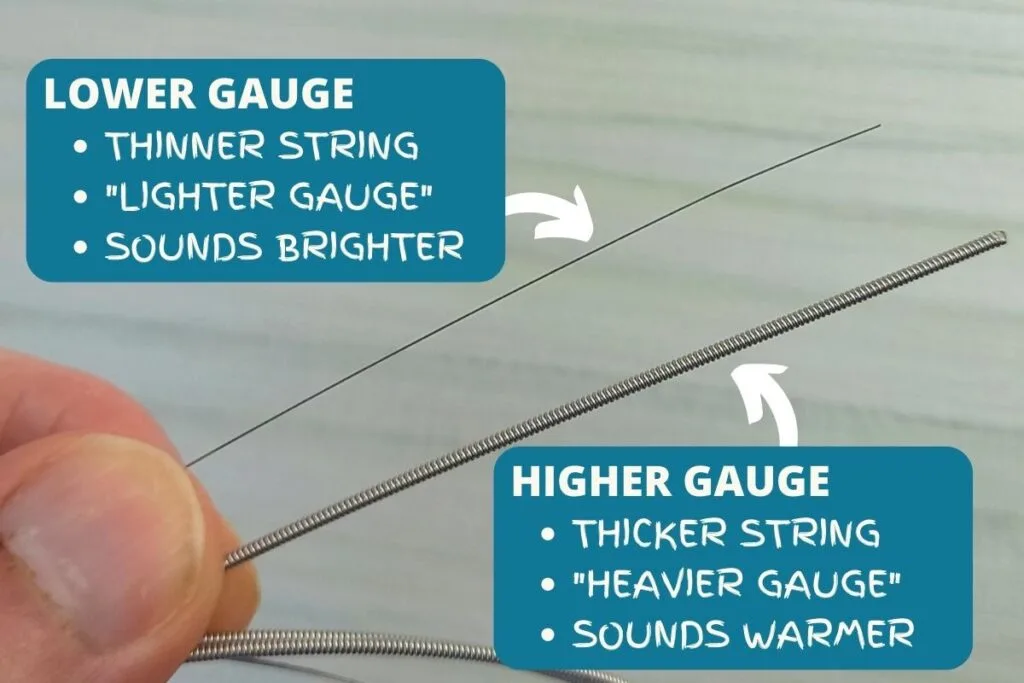
String gauge has a large effect on both the sound and feel of your guitar. Just take a look at the top and bottom string of your guitar! Beginner guitarists often start with a set of lower gauge strings, as there’s less resistance and they can build up some finger strength.
Over time, guitarists tend to develop preferences by learning which gauge strings work best for them and their playing style through experimentation.
Picking up a pack
When you buy a set of guitar strings, the string gauges will be shown as numbers somewhere on the packaging. To help you out, most manufacturers also use descriptive words to give you an idea of how thick or thin the strings are. The best example of this is Ernie Ball telling you how “slinky” (thin) their strings are.

In most cases, guitar strings sets are often referred to by the gauge of the thinnest string. For 6 string guitars, this is the high E string. In the picture above, the high E string is a gauge 9, so this pack of strings would be called “9’s”.
How does string gauge affect your guitar?
String gauge makes a huge impact on your guitar’s overall sound and feel. The difference between two sets of strings can be like night and day, even though it’s just a fraction of an inch difference.
This is mostly due to string tension. String tension how tight the string is on your guitar, and how much pressure it puts on the guitar’s neck.
Higher gauge strings have a higher string tension when compared with thinner strings on the same guitar.
Let’s take a look at how this affects different aspects of your guitar.
Playability
The thing that I, and most other guitarists, first notice when playing different gauge guitar strings is how they feel.
Higher gauge strings have a higher string tension which makes them harder to play with, as there’s more resistance from the string. This means that you have to push harder against the strings to fret or bend a note.
Lower gauge strings are thinner, and are much easier to play with. On the flip-side, a gauge that’s too light can bend too easily, making playing chords sound out of tune.
Generally speaking, lower gauge strings are easier for beginners, as they help to build up finger strength. Think of it like weight lifting: it’s a lot easier to start with a light weight, and build your strength up to using the higher weights.
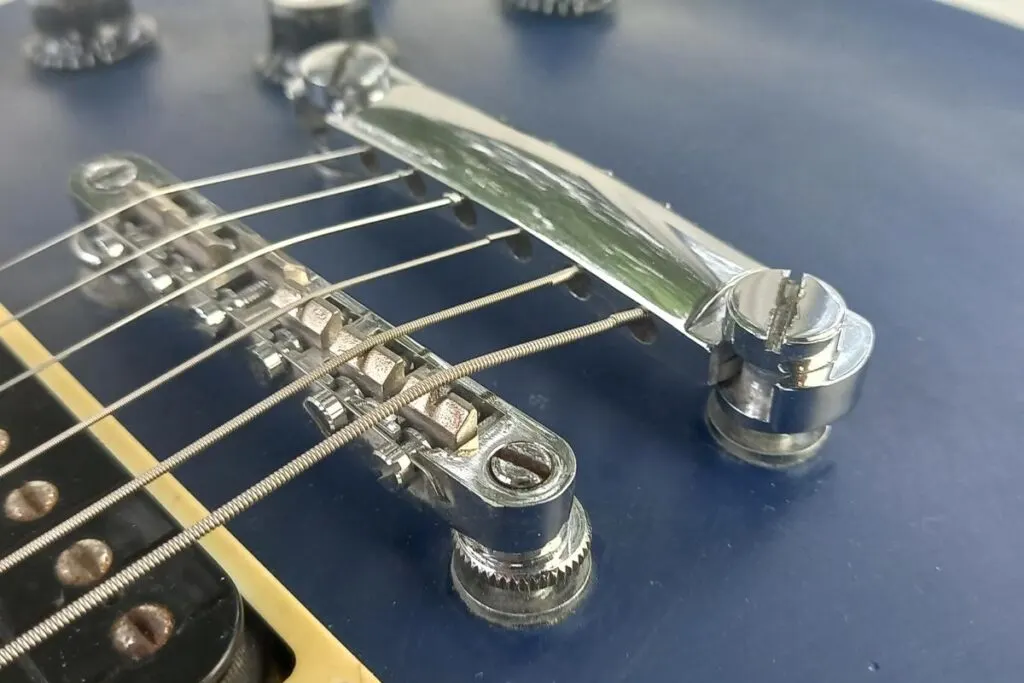
String tension is also affected by your guitar’s scale length. Guitars with a longer scale length (more distance between the nut at the headstock and the bridge) will have a higher string tension than a guitar with a shorter scale length, when both are tuned up to the same pitch.
So, if you have a guitar with a shorter scale length (like a 3/4 sized guitar for example), you’ll find that higher gauge strings will feel looser, compared to a regular sized guitar.
This is one of the reasons that I use different gauge strings on my Les Paul and my Stratocaster. What feels right on one guitar can feel completely different on another.
Tuning
Have you ever tried tuning your strings down, and they end up sounding like a floppy mess? String gauge plays an important role in how well your guitar can handle certain tunings.
Heavier gauge strings can handle lower tuning better, as they have more string tension. The string tension keeps them tight, despite them being lower pitched. Using a thinner string for lower pitched tuning can become too flexible, and cause fret buzz.
Again, scale length comes into play. Baritone guitars, with their long scale length, are able to handle lower tunings with lighter gauge strings. So, it’s all relative to the guitar that you’re playing!
If you’re looking to tune your guitar lower than the standard “EADGBe” tuning, and your strings are becoming too loose, I recommend getting a higher gauge set of strings.
Intonation
While we’re talking about tuning, string gauge can also affect your guitar’s “intonation” – how “in tune” it is across the neck.
Setting a guitar’s intonation requires making small adjustments to the saddles on the bridge that slightly change the length that the guitar string vibrates.
Using a string that’s a different gauge to your normal set will mean that it sits slightly differently on the saddle, which can affect the intonation.
Fortunately, it’s not a big deal. Just make some minor adjustments, and your guitar will be fully intonated again!
Tone
String gauge has a big effect on the tone of your guitar. Heavier gauge strings have a warmer, bass heavy tone, whereas lighter gauge strings sound brighter, with more treble frequencies.
Thicker strings also tend to be louder than thinner strings because of the increased string tension. When they’re plucked or strummed, they vibrate more.
This makes heavy gauge strings perfect for genres like rock and metal, where you want your guitar to sound loud and beefy. Lighter gauge strings are perfect for country and funk music, because of the ringing treble frequencies.
Guitar setup
I touched on this earlier – changing your guitar strings to a different gauge can mean that you need to adjust your guitar’s set up. This includes adjusting the truss-rod in the neck, the saddles at the bridge, and the springs for tremolo bridges (if the bridge starts to lift from the string tension). Otherwise, you’ll likely end up with fret buzz and intonation problems.
This shouldn’t stop you from experimenting with a higher gauge string, just be mindful that your guitar might need some tinkering to sound right.
Finally, if the strings are too thick, it can mean that they don’t sit securely in the guitar’s nut. This can be a bit of a problem. In my experience, even the thickest strings I’ve used (gauge 12-52) have fit my guitar’s nut, albeit tightly. If this is the case for you, then you might need the nut slot widening, or the nut replacing entirely. Though, it’s probably easier just to drop to a thinner string gauge!
Which string gauge should you use?
There’s no set rule for which gauge string to use – it’s all down to personal preference and playing style. That being said, here’s a few pointers to help find the right string gauge that’s right for you.
Light gauge strings
I’d classify a lighter gauge string as either an 8 or 9 gauge set of strings.
This string gauge is perfect for:
- Beginners looking to build up their hand strength
- String bending
- Lead guitar solo’s and shredding
- A bright guitar tone
If this sounds like you, I recommend picking up a pack of Ernie Ball Super Slinky’s. They’re the guitar string that I used when I first started playing guitar, and I still find myself coming back to them every few string changes! They’re light and flexible, but they don’t bend too easily, which means you can play chords without worry!

Medium gauge strings
To me, a medium gauge string is either a 10 or 11. At this gauge, the strings start to feel firmer, but are still bendable. They also sound a lot more powerful and fuller than lighter strings, and have a warmth to the tone.
These strings are great for:
- Multipurpose playing (rhythm and lead)
- Balanced tone between warm and bright
- Firm string tension, with flexibility
- Good sustain
I currently use D’Addario 10’s on most of my guitars. I like the way that they feel and sound. To me, they’re best of both worlds: a string with both warmth and brightness, flexibility and firmness. I recommend these strings if you’re looking for an general all-rounder string that you can swap between genres with.
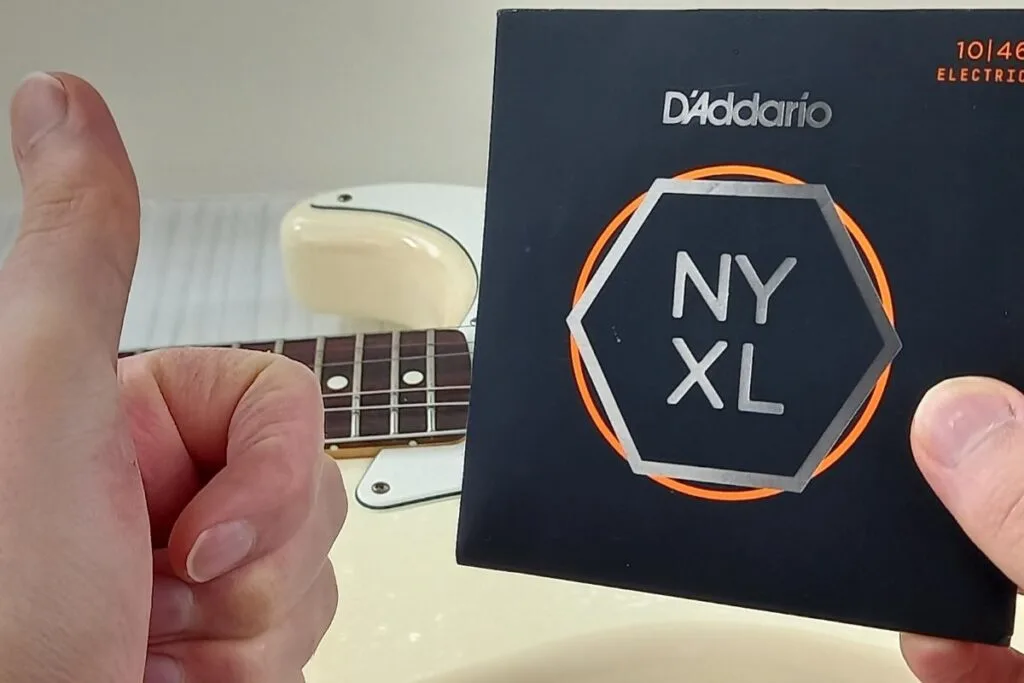
Heavy gauge strings
Heavy gauge strings are anything over a 12. At this string gauge, you’ll have a hard time bending the strings. And fretting notes will take a bit more pressure. But, you’ll get a very deep and rich tone from your guitar. Not only that, but you’ll be able to tune your strings lower without getting any rattle or fret buzz.
The increased string tension also makes them great for sustain and volume.
These strings are best suited for:
- Loud rhythm guitar
- Hard rock and metal music
- Drop tuning
- A warm, powerful sound
I use Ernie Ball “Not Even Slinky’s” on my Les Paul that I have tuned to Drop C. I recommend these for anyone who wants a heavy gauge set of strings. They sound incredibly warm and loud, and have amazing sustain. That being said, they are tough to bend though and fretting notes is a bit harder.
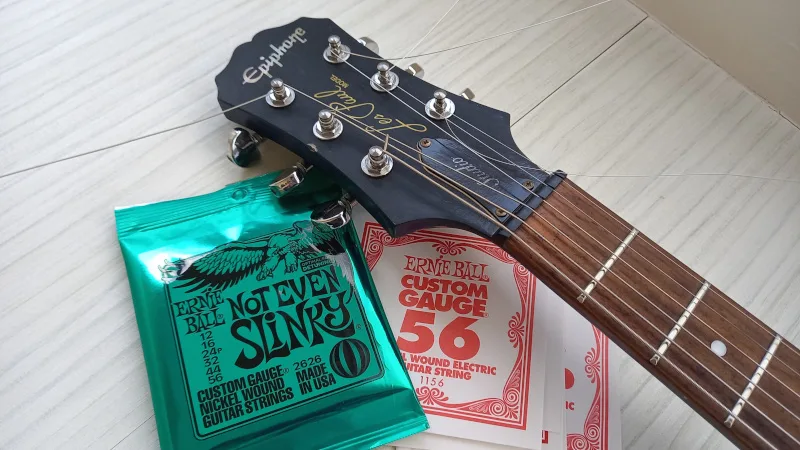
Hybrid strings
What about the players who want it all: the flexibility for soloing, but the warmth and weight for rhythm? In this case, I’d recommend checking out hybrid strings.
Hybrid strings are sets of strings that have non-traditional pairings of string gauges together. Most commonly, hybrid strings tend to have much thicker bottom strings (E, A, D) than normal sets. This gives players beefy sounding strings that have plenty of volume, but thinner top strings that are easy to bend for soloing.
If this sounds like your kind of string gauge, then check out the Ernie Ball Hybrid Slinky’s. They’re 9’s (Super Slinky) with a much thicker set of low strings. Perfect for the guitarist who want’s it all!

Summary
String gauge is a way of measuring how thick a guitar string is, but it’s effect is all relative to each individual player, the guitar they use, their tone preferences… and so on.
Here’s a few key takeaways:
- Thinner strings sound brighter and are easier to bend. Thicker strings sound warmer and are harder to bend.
- Thicker strings have a higher string tension, which makes them louder, have better sustain, and are good for drop tuning.
- Changing from one string gauge to another may mean that you have to adjust your guitar’s setup.
The best way to learn about string gauges is to get out there and play. So, try picking up a set of new strings, and see how they feel – you might just be surprised!
Leave a comment and let me know which string gauge you use, and why!
Related questions
What is the standard guitar string gauge?
Most electric guitars come strung with gauge 9 strings. This is because they’re flexible and easy to play, which makes them suitable for most people, especially beginners.
Can you change guitar string gauges?
Yes, you can change your guitar strings to a new gauge. However, you may need to readjust your guitar’s neck, saddles, and bridge. This is because the string tension will be different, and will put more or less tension on the guitar.
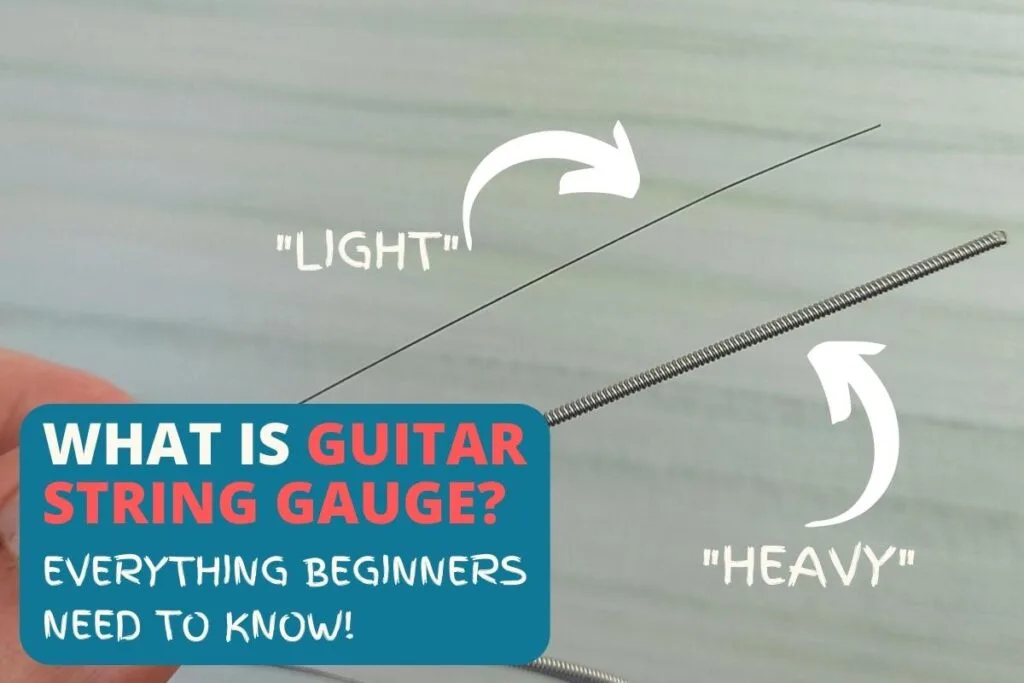

Conor is a music producer, multi-instrumentalist, and all-round enthusiast from the UK with over 15 years of experience. He’s the founder and sole-content creator for the roundtable audio blog and YouTube channel.
